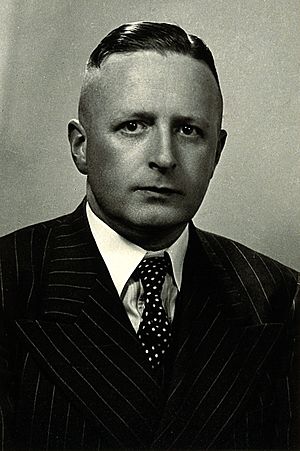Alexander Haddow facts for kids
Sir Alexander Haddow (born January 18, 1907 – died January 21, 1976) was a Scottish doctor and scientist. He was a very important figure in cancer research during the 1940s. He led the Institute of Cancer Research from 1946 to 1969. He also served as the President of the Universal Union Against Cancer, an international group fighting cancer.
Sir Alexander Haddow made a huge discovery called the Haddow Effect. This effect showed that some chemicals that can cause cancer might also be used to stop the growth of other cancers. This was a big step forward in understanding how to fight the disease.
Contents
Early Life and Inspiration
Alexander Haddow was born on January 18, 1907, in Leven, Fife, Scotland. His father and grandfather were coal miners. His family later moved to Broxburn, West Lothian, where his father ran a small hotel and bar.
When he was 10, Alexander became very sick with scarlet fever. He remained quite weak and shy after that. At age 11, he also had appendicitis. The family doctor, Dr. Alexander Scott, treated him both times. Dr. Scott became a big role model for young Alexander. Dr. Scott was known for studying skin cancers in local miners. Alexander went to Broxburn High School and then Broxburn Academy, where he was a top student.
Education and Early Career
In 1929, Alexander Haddow finished his medical studies at the University of Edinburgh. He earned a degree that allowed him to become a doctor.
He then worked as an assistant at the Edinburgh Royal Infirmary. He also taught about bacteria at the University of Edinburgh. By 1932, he became a full lecturer there. The university recognized his hard work and gave him three more advanced degrees between 1937 and 1938.
Leading Cancer Research
In 1936, Haddow moved to London. He joined a research team at the Royal Cancer Hospital. This team was led by Ernest Kennaway, another important cancer researcher.
In 1946, Sir Alexander Haddow took over from Kennaway. He became the Director of the Chester Beatty Research Institute. This institute was later renamed the Institute of Cancer Research. He led this important center for many years.
His work was recognized by many. In 1958, he became a member of the Royal Society of London. This is a very old and respected group of scientists. In 1961, he also became a member of the Royal Society of Edinburgh. In 1966, Queen Elizabeth II made him a knight, giving him the title "Sir."
Sir Alexander Haddow retired in 1972. By this time, he had serious health problems due to diabetes.
Personal Life
In 1932, Alexander Haddow married Lucia Lindsay Crosby Black. She was also a doctor. Their son, William George Haddow, was born in 1934. Lucia passed away in 1968.
In 1970, he married again to Mrs. Feo Standing. She was a scientific photographer. Through this marriage, he gained two step-children.
Later Life
Sir Alexander Haddow had diabetes and related health challenges. He passed away on January 21, 1976, at Amersham General Hospital in Amersham, England. He was 69 years old.


